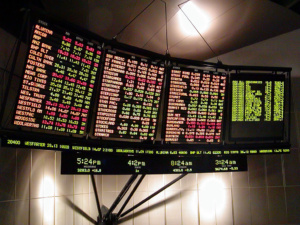Multi-asset trading during periods of high volatility: Retail traders take on the institutional world
Equipped with algorithmic trading solutions, retail traders today are able to navigate periods of high volatility in the same way that the trading desks of resource-rich institutions can.

Periods of high volatility have become something of a cat-and-mouse affair within many FX brokerages these days.
If there is a geopolitical event such as last week’s rally of currency volatility as traders attempted to cash in on the results of the British referendum on European Union memebrship resulting in a massive spike in trading activity among retail traders to the point at which brokers using technology provider Leverate’s solution, all of which are retail brokerages, conducted an extra 277% of volume via the liquidity service that the company offers during that week alone.
It was not just the currency markets that attracted very high trading volumes as traders did not fear the potentially adverse consequences of volatile markets, but also the commodities and stock markets that were the subject of some very accurate analysis that allowed some astute traders to navigate the market very effectively indeed.
Saxo Bank’s equities desk was a case in point. The company opened 21 aggressive trades on company stock in one day, with the company’s Head of Equity Strategy speaking to FinanceFeeds last week from Saxo Bank’s head office in Hellerup, Denmark explaining “When the cash market opened our first aggressive trade was in Repsol (REP:xmce) that opened 18% down despite energy stocks in Asia on average were only down 2-4% This was the first gross mispricing in the European equity market.”
“We immediately bought large exposure and the stock rebounded 12% in 13 minutes. That made us smell blood in the streets!!” – Peter Garnry, Head of Equity Strategy, Saxo Bank
The company also placed small directional bets on a scenario in which the UK may remain in the EU, one of them being a long Nikkei 225 and also long on UBI Banca, however the firm adapted its strategy following the result and began rapid intraday trading in 21 instruments for the first 90 minutes of the European cash equity trading. This is when the firm began to profit from its Repsol deals.
“We could not send out trading ideas out to clients at that speed as we had to seize the opportunityto take advantage of the exceptional levels of mispricing. We did circulate our activity ad hoc on emails to clients” said Mr. Garnry.
“Our first position was aggressively adding a large exposure in STOXX 50 in the area 2,675-2,700 immediately taking our portfolio from gross exposure of around 100% and net exposure of 7% to around 200% gross and 107% net” – Peter Garnry, Head of Equity Strategy, Saxo Bank.
“When the UK banks opened down 30-35%, we immediately copied our Repsol trade in Barclays and Royal Bank of Scotland” continued Mr. Garnry.
So, how do you, as a retail trader master a market which is volatile and make the most of a situation in which it is possible to trade quickly and effectively across multiple asset classes, emulating the highly technologically advanced and resource-rich trading desks of the major firms.
Today, FinanceFeeds spoke to electronic trading technology specialist Tradency, whose CEO Lior Nabat explained “Tradency stands out due to the fact that its data comes from professional, experienced trader such as hedge funds and algo-development companies, with aggregated tens of years of experienced in the market.”
“Tradency’s algos are diversified and trade many different assets” continued Mr. Nabat.
We have noticed that in volatile “black swan” times such as the recent Brexit, the professional expert traders stayed off the game. Letting the market find its direction again and only then re-entering. By that they are protecting their algos and the traders following them from the turmoil but still enter the market in time to leverage on the changes”- Lior Nabat, CEO, Tradency
In conclusion, Mr. Nabat said “The vast majority of Tradency’s algo providers did not open any positions during the Brexit but waited a short while and only then did they send signals again.”
This alludes toward a base of traders which waited, biding their time, until the result of the referendum was announced and then began to operate their algorithmic systems again, therefore trading a very volatile market.
It is of great interest that traders were not scared away from the markets by the potential volatility that could have ensued, and the very real volatility that did ensue from Britain’s decision to leave the European Union.
Indeed, quite the contrary. Using sophsiticated trading technology which spans multiple asset classes and often uses algorithmic methodology whilst backed by brokerages that have implemented prudent risk management spurred a trading spike, even against headwinds such as the interbank FX dealers having increased the spread on GBP pairs by half a cent on June 22.
It is becoming very clear indeed that there is a vast segment of traders worldwide which are confident, familiar with the entire structure of the markets and are emulating their peers in the institutional world.









